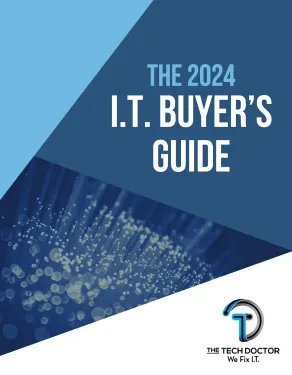Cybersecurity: Top Threats and How to Avoid Them
Cybersecurity threats are more advanced than ever in 2025. Discover the top risks and get practical advice from The Tech Doctor to keep your data safe online.
Cybersecurity: Top Threats and How to Avoid Them
In a world that’s increasingly digital, cybersecurity is no longer optional—it's essential. Cyberattacks are growing more frequent, complex, and damaging. Whether you’re a small business, a freelancer, or a casual internet user, your personal and professional data is at risk.
As cybercriminals evolve their tactics, you need to stay informed and proactive. At The Tech Doctor, we believe that knowledge is your first line of defense. This blog breaks down the top cybersecurity threats and offers expert tips to strengthen your information security, protecting your data, devices, and digital identity.
Phishing Attacks: Don't Take the Bait
Phishing remains one of the most common and effective forms of cybercrime. These attacks typically involve fraudulent emails or messages that trick you into clicking on malicious links, downloading harmful attachments, or entering sensitive login credentials into fake websites. Cybercriminals often impersonate trusted sources such as banks, government agencies, or even coworkers.
What makes phishing especially dangerous is how convincing the messages can look. A successful attack can lead to identity theft, unauthorized access to your accounts, or the installation of malware on your device. To avoid falling victim, always double-check the sender’s email address and hover over links to preview their destination before clicking. Use spam filters, enable two-factor authentication (2FA), and educate your team or family on how to spot red flags. Preventing phishing starts with vigilance and awareness.
Ransomware: A Costly Digital Hostage Situation
Ransomware is a type of malware that encrypts your files and demands a ransom—usually paid in cryptocurrency—for their release. Some strains go a step further and threaten to publish your data if the ransom isn’t paid. This form of attack is particularly damaging to businesses, government institutions, and healthcare organizations.
In recent years, ransomware attacks have increased significantly, with many incidents resulting in millions of dollars in losses and reputational damage. To protect yourself or your business, ensure that you regularly back up your data to external or cloud storage solutions. Keep your software and operating system up to date to patch known vulnerabilities and strengthen your ransomware protection. A reputable antivirus solution with real-time protection is also a must. Limit admin access to critical systems and avoid opening unsolicited email attachments or clicking on links—prevention is always cheaper and safer than paying a ransom.
Weak Passwords and Poor Credential Management
Despite ongoing warnings, many users still rely on weak or reused passwords, making it easy for hackers to gain access to accounts through brute force attacks or data breaches. Credential stuffing—a tactic in which stolen usernames and passwords are used to attempt to access multiple sites—is on the rise.
Strong credential management is one of the most fundamental steps in improving your cybersecurity. Use long, complex, and unique passwords for each of your accounts. A password manager can help you generate and store strong passwords securely. Enabling multi-factor authentication (MFA) adds an extra layer of security, requiring you to verify your identity through a secondary method. Avoid using personal information, such as birthdays or pet names, and never reuse the same password across multiple platforms. It might seem inconvenient, but it’s far less disruptive than dealing with a compromised account.
Public Wi-Fi: Convenient But Risky
Public Wi-Fi networks, like those in cafes, airports, and hotels, are incredibly convenient—but they’re also breeding grounds for cyber threats. Many public networks lack basic security measures, making it easy for hackers to intercept your data using methods such as man-in-the-middle attacks. Some attackers even set up rogue Wi-Fi hotspots that look legitimate but are traps.
To protect yourself, avoid accessing sensitive information—like banking or email accounts—when using public Wi-Fi. If you must connect, use a trusted virtual private network (VPN) to encrypt your traffic. This makes it far harder for anyone to see what you’re doing online. Also, disable automatic Wi-Fi connections on your devices and ensure that the websites you visit use HTTPS encryption. Small precautions can prevent big problems when you’re on the go.
Outdated Software and Unpatched Systems
Cybercriminals frequently exploit known vulnerabilities in outdated operating systems, apps, and software. If you delay or ignore updates, you're leaving the door open to a wide range of attacks, including zero-day exploits—vulnerabilities that are actively being used by attackers before the developer has released a fix.
Keeping your software up to date is one of the simplest and most effective ways to improve your cybersecurity. Enable automatic updates for your OS, applications, antivirus programs, and firewalls. Routinely check for software patches and remove unused or outdated programs from your devices. Stay informed by monitoring security advisories from vendors. Regular maintenance might seem tedious, but it drastically reduces your risk of attack.
Build a Cybersecurity-First Mindset
Cybersecurity goes beyond installing antivirus software — it’s about adopting a mindset that prioritizes digital safety and network security in every online action you take. Threats will continue to evolve, but so can your defenses. Whether you're a casual user or a business owner, taking proactive steps now can save you time, money, and stress in the future.
By understanding these five major cybersecurity threats—phishing, ransomware, weak passwords, unsafe Wi-Fi, and outdated software—you can take concrete action to protect yourself and those around you. Stay informed, stay cautious, and never underestimate the value of digital awareness.
Bonus tip: Consider investing in penetration testing (pen testing) to proactively identify and address hidden vulnerabilities in your systems. This simulated attack process helps strengthen your defenses and reduce the risk of a real-world cyber breach.
Need Help With Cybersecurity? Contact The Tech Doctor!
Whether you’re an individual seeking to protect personal data or a business looking for comprehensive IT security solutions, The Tech Doctor is here to help. Our experts offer cybersecurity services, including audits, training, and proactive defense systems. We make it easy to secure your digital life—before it's too late.
Contact us today for a complimentary consultation and let The Tech Doctor be your trusted partner in cybersecurity.


About The Tech Doctor
The Tech Doctor specializes in providing B2B managed IT and Managed Security Services in New Braunfels, Texas, delivering expert tech solutions that enhance operational efficiency and security for businesses.








